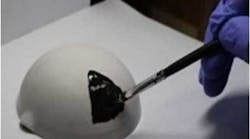Thermoelectric generators, also known as Seebeck generators, are solid-state devices that can be used to recycle waste heat from devices into useable electricity. That has big implications for automotive, industrial, and other markets–but only if they can be applied to a surface that complements their shape.
The rigidity of these devices can limit their ability to interface with curved or irregular surfaces. The gaps between the generator and the surface cause heat to be lost to the atmosphere. To address this problem, researchers from the Ulsan National Institute of Science and Technology (UNIST), Korea Institute of Science and Technology (KIST), and the Korea Electrotechnology Research Institute have invented a thermoelectric paint that can be directly applied to hot and cold surfaces.
According to the report published in Nature Communications last month, the thermoelectric paint can be applied to the surface of a metal dome (shown above) using a paintbrush. The dome has a temperature gradient that spans from top to bottom, with a high temperate at the top of the dome. Alternating coats of p-type and n-type thermoelectric semiconductor paint were applied to the dome to generate a voltage between electrodes placed at the top and the base of the dome.
The performance of the paint relies on having low heat conductivity to maintain the temperature gradient over the top and the base of the dome. Conversely, it must also have high electrical conductivity to perform well in an electrical circuit. The team chose to use bismuth telluride (Bi2Te3) because it is one of the few semiconductors with a thermal conductivity that remains nearly constant as more charge carriers are introduced through doping at room temperature. The team mixed the Bi2Te3 with a Sb2Te3 sintering aid so that the paint would coalesce–or become denser–when heated, ultimately improving its energy-conversion efficiency.
Equation for thermoelectric performance
Performance of a thermoelectric material can be measured by a unit-less figure of merit, ZT, which depends four intrinsic and extrinsic factors. The performance improves when the electrical conductivity, σ, is high, but it decreases when the thermal conductivity, κ, is high. That is why κ is in the denominator in the following performance equation:
ZT=(S2σT/κ)
Performance also depends on the Seebeck coefficient, S, which is an intrinsic property. Measured in Volts per unit Kelvin, it defines the rate of carrier motion per unit temperature change. A challenge for thermoelectric materials is that the Seebeck coefficient tends to decrease when the charge carrier concentration (electrical conductivity) increases past a certain threshold. And finally, the height of performance will increase over a wider temperature gradient, T.
For the thermoelectric paint, the scientists were able to achieve a ZT value as high as 1.21 for the p-type semiconductor, and a ZT value of 0.67 for the n-type. These values are not high enough to be used for most applications, but they outperform other approaches to making free-form thermoelectric devices.. In conventional thermoelectric devices, the ZT tends to be as high as 2 or 3. In addition, the entire device generated a power output of 4 mW per square centimeter. The team expects to keep developing the formula to improve its performance for real-wold applications.



